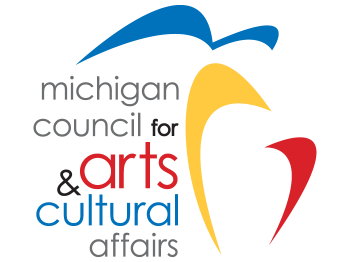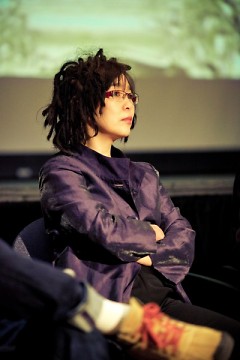When the Arts Council of Greater Grand Rapids, Artpeers, and Avenue for the Arts partnered up to sponsor a panel discussion about the role of arts criticism in Grand Rapids, we titled it “Critical Reality: Why Is Arts Criticism Important?”
The attempt to negotiate a multitude of perceived realities became the underlying focus permeating most of the points brought up in Thursday night’s conversation.
For example, what is the “real” meaning of the word “criticism”, especially “arts criticism?"
"Arts criticism is..."
Moderator Jenn Schaub opened the discussion with a few thoughts on the definition of the latter, summing it up with the phrase's basic use: “Art criticism is the act of contextualizing a work of art.” The challenge for the night was discovering how and where to ground that act of contextualization.
The first question was straightforward: are there examples of art criticism in Grand Rapids? Panelist Kevin Buist (writer, artist, Artist Relations director at ArtPrize) praised The Rapidian as a potential sustainable vehicle for local arts criticism, citing it as one of the public forums where arts criticism does happen currently. Elizabeth Goddard (UICA) and Ritsu Katsumata (musician, creative director at Amway) agreed that The Rapidian is a place where critical dialogues about art can be found both in the articles and reader commentary. Paul Wittenbraker (artist, Grand Valley State University Art & Design faculty) listed some additional, less widely-known sources, past and present, and Jeff Kaczmarczyk (Arts & Entertainment reporter, Grand Rapids Press, MLive) also contributed names. But there seemed to be an unspoken agreement amongst the panelists that there was no single source that they all read or would recommend as a source for arts criticism.
No Single Voice
The “reality” that revealed itself almost immediately was that Grand Rapids isn’t looking for what Ritsu called “a single voice speaking to the masses.” Addressing the second question, which asked the panelists what they thought about new forms of art criticism – like videos and blogs – Ritsu explained that the job that once belonged to newspaper and magazine editors has become “crowdsourced”, coining a term for a phenomenon Buist also touched on. In an age when information is available from a variety of sources, both edited and self-published, readers are the editors. When a reader contributes to a piece’s popularity by reading it and sharing it through social media outlets, Buist explained, he or she ensures that others will see the piece as well, ultimately playing a role in its sucess.
A "Concerned" Platform
While Wittenbraker agreed with the panel’s general consensus that the communications landscape has changed, with new platforms making the arts world, as Goddard put it, more “inclusive and accessible”, he emphasized the reality of how difficult concepts come to be clarified: it’s a process. An editing or “concerned” platform is necessary when writers are addressing ideas that are inherently challenging, as this setup ensures that time and other resources will be invested in transforming those ideas into something accessible. In other words, advocating for more systematic means of publishing arts criticism isn’t automatically advocating for intellectual or arcane vehicles, but for a platform that will generate clearer, more generally informative critiques.
Growing Up
Though the audience was invited by Schaub before the discussion to chime in with questions or comments at any time, hands didn’t start coming up in earnest until the third question. After being asked whether the size of our community is an obstacle or an asset, the panelists strayed the furthest off-topic they got all night. Wittenbraker and Buist did eventually address the issue, but some of the most informative responses came from the seats. Local artist Rick Beerhorst offered an analogy that was afterwards returned to many times. “We’re growing as an art community…we’re having these conversations because we’re in this fumbling toward adolescence as an art community, so, having said that, the art criticism is extremely important to us growing up.” He then added that we need to “…press through that awkwardness and start developing it.”
Not The End of the Story
Having established that the host of new mediums and the thriving creative community here can, combined, make a new breed of local arts criticism possible, another reality arose for the panelists to deal with. Why should anyone care? The last few questions Schaub asked of the panelists teased out plenty of reasons. In a place where art is being made, and thanks to ArtPrize, being seen and talked about, arts criticism can function as an educational tool. Panelists and audience members alike agreed that a piece of criticism is, as Wittenbraker explained, not “the end of the story.”
“It’s most beneficial when it doesn’t die on the page,” said Goddard. Examples from the seats and stage, ranging from a “What the Hell Was That?” seminar at the Ann Arbor Film Festival, art history classes at universities, and artist salons and other types of peer review, prove that we can educate and challenge each other in many different contexts. Reading and discussing critical pieces should serve as the springboard rather than the cap on those dialogues.
The turnout for the event was impressive. After the event had been announced, interest began to accelerate and it was moved from the original location in the Arts Council’s offices to the Wealthy Theatre. A few days before “Critical Reality” took place, the number of RSVPs prompted us to move it from the Koning Micro-Cinema to the main Peter Wege Auditorium. Comment cards collected after the event urged us to continue the dialogue with future related events, and to try to more actively engage attendance outside of the arts community as well.
Maureen Di Virgilio is the Writing & Marketing Intern at the Arts Council of Greater Grand Rapids
The Rapidian, a program of the 501(c)3 nonprofit Community Media Center, relies on the community’s support to help cover the cost of training reporters and publishing content.
We need your help.
If each of our readers and content creators who values this community platform help support its creation and maintenance, The Rapidian can continue to educate and facilitate a conversation around issues for years to come.
Please support The Rapidian and make a contribution today.



